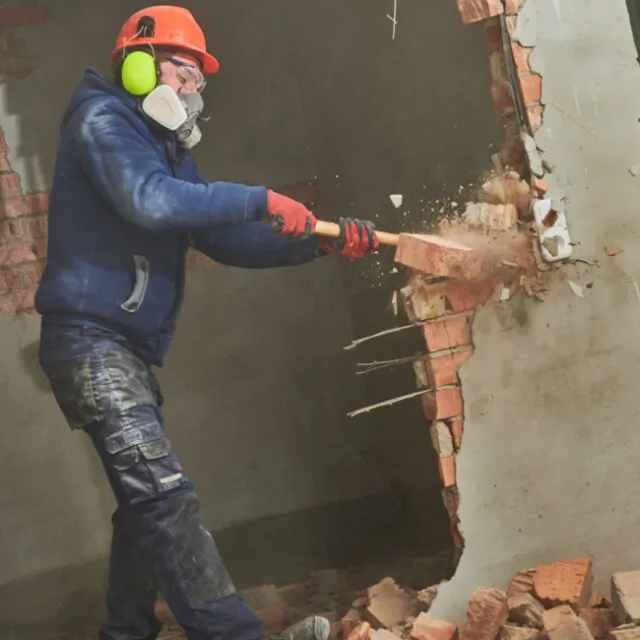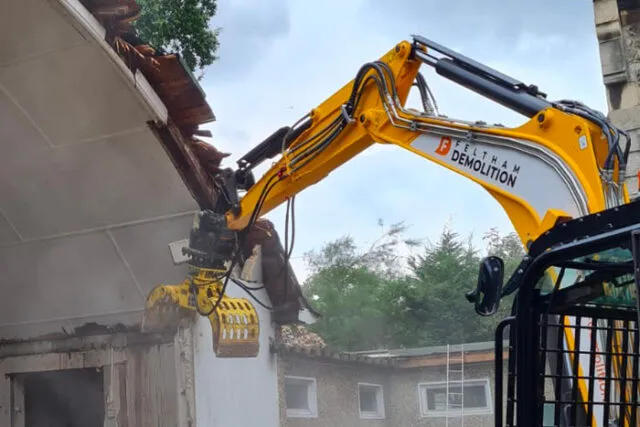Over the past 12 months, we have seen a surge in new client projects thanks to our sustainability practices. When people think of demolition, they tend to imagine a lot of leftover debris, loud machinery, and dust pollution that create a negative impact on the environment, but it is quite the opposite.
In the majority of the projects we work on, whether it be a full commercial office demolition, a smaller house demolition, or a building strip out, our number one objective is to be as considerate to our surroundings.
We have strict rules for our team and our partners, ensuring all structures are demolished in the cleanest way possible, keeping noise pollution to a minimum and removing debris as we go so nothing is left behind. We also use battery-powered robot demolition machines and much of the strip-out work is done by our team using their hands.
Once the materials are removed from the structure, they are sorted into piles where they can then be transported to a recycling centre. Through our recycling processes, we are at a 99% recycling level, with asbestos being the only exception.
With recycling and sustainability in remind, we thought we would share our 10 favourite ways that we use to ensure our demolition remains sustainable and ethical.
Selective Demolition
We conduct a selective demolition where we can, salvaging and reusing materials from the existing structure. This minimises the amount of waste we send to landfills and promotes resource conservation.
Deconstruction
Deconstruction (also called Strip-out) involves carefully dismantling a structure to salvage materials for reuse. This method minimises waste and can contribute to the recycling of valuable building components, especially for metals.

Material Recycling
With the help of partners, we have implemented a comprehensive recycling program to ensure that as many materials as possible, such as concrete, metal, plastics, lead, and wood are recycled rather than disposed of in landfills. On larger projects, we will have our mobile concrete crusher on site that enables us to remove concrete in a more efficient way and take it directly to another project. The concrete is then used as a base for building new structures. We aim to recycle 98% of materials from every project.
Dust Control
We always implement effective dust control measures during the demolition process to airborne particles. This is especially important for projects where protective species may live, or in built up areas where children and the elderly may reside. This helps protect air quality and reduces the environmental impact of particulate matter.
These dust control measures can include misting canons, regular site maintenance, storing materials such as soil and concrete correctly, and even using low dust equipment. Implementing site hoarding helps us minimise the spread of airborne particles to the wider area.
Water Management
We use water suppression techniques to control dust and prevent pollutants from spreading. Proper water management is implemented to protect nearby water sources from contamination.
Hazardous Material Removal
We identify and safely remove hazardous materials, such as asbestos and lead, before demolition. This prevents the release of harmful substances into the environment, and reduces the risk to the Feltham team.

Energy-Efficient Equipment
We use energy-efficient machinery and equipment during the demolition process. This reduces the overall energy consumption and minimises the environmental footprint of the demolition activities. For example, we have a Robot demolition machine that is cost-efficient to use, safe, fast, and has a relatively low noise footprint.
Native Greenery Protection
Where possible, we implement measures to protect nearby native vegetation and ecosystems. This includes creating buffer zones, using sound barriers, to reduce the disturbance to the natural habitats surrounding the project. This is especially important when working on brown belt and green belt projects
Noise Reduction
As already mentioned, we take various noise reduction measures to reduce the impact on local communities and wildlife. This sometimes includes scheduling demolition activities during specific hours and using barriers to deflect noise.
Community Engagement
Projects are made a lot easier and more enjoyable if the local community are on board and in agreement from the very start. It also helps if they are aware of the measures we take to improve our sustainability.
We regularly engage with the local community and stakeholders to address concerns, gather input, and ensure that the demolition process takes into account the environmental considerations of the surrounding area. This is especially important on historic buildings or buildings of prominence.
By incorporating these environmentally friendly practices, our demolition projects can be conducted with a reduced ecological impact, promoting sustainability and responsible construction practices.
At Feltham Demolition, we believe that demolition should be done right, regardless of cost or workload.

